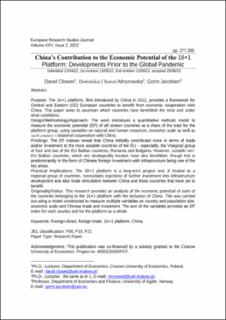| dc.contributor.author | Clowes, David | |
| dc.contributor.author | Choros-Mrozowska, Dominika | |
| dc.contributor.author | Jacobsen, Gorm | |
| dc.date.accessioned | 2023-06-07T12:22:14Z | |
| dc.date.available | 2023-06-07T12:22:14Z | |
| dc.date.created | 2022-11-28T09:56:24Z | |
| dc.date.issued | 2022 | |
| dc.identifier.citation | Clowes, D., Choros-Mrozowska, D. & Jacobsen, G. (2022). China’s Contribution to the Economic Potential of the 16+1 Platform: Developments Prior to the Global Pandemic. European Research Studies Journal, 25 (2), 277-289. | en_US |
| dc.identifier.issn | 1108-2976 | |
| dc.identifier.uri | https://hdl.handle.net/11250/3070374 | |
| dc.description.abstract | Purpose: The 16+1 platform, first introduced by China in 2012, provides a framework for Central and Eastern (CE) European countries to benefit from economic cooperation with China. This paper seeks to ascertain which countries have benefitted the most and under what conditions. Design/Methodology/Approach: The work introduces a quantitative methods model to measure the economic potential (EP) of all sixteen countries as a share of the total for the platform group, using variables on natural and human resources, economic scale as well as each country’s bilateral cooperation with China. Findings: The EP indexes reveal that China initially contributed more in terms of trade and/or investment to the more sizeable countries of the EU – especially, the Visegrad group of four and two of the EU Balkan countries, Romania and Bulgaria. However, sizeable non-EU Balkan countries, which are strategically located, have also benefitted, though this is predominantly in the form of Chinese foreign investment with infrastructure being one of the key areas. Practical Implications: The 16+1 platform is a long-term project and, if treated as a regional group of countries, necessitates injections of further investment into infrastructure development and also trade stimulation between China and those countries that have yet to benefit. Originality/Value: This research provides an analysis of the economic potential of each of the countries belonging to the 16+1 platform with the inclusion of China. This was carried out using a model constructed to measure multiple variables on country and population size, economic scale and Chinese trade and investment. The sum of the variables provides an EP index for each country and for the platform as a whole. | en_US |
| dc.language.iso | eng | en_US |
| dc.publisher | International Strategic Management Association (ISMA), E. Thalassinos | en_US |
| dc.rights | Navngivelse 4.0 Internasjonal | * |
| dc.rights.uri | http://creativecommons.org/licenses/by/4.0/deed.no | * |
| dc.title | China’s Contribution to the Economic Potential of the 16+1 Platform: Developments Prior to the Global Pandemic | en_US |
| dc.title.alternative | China’s Contribution to the Economic Potential of the 16+1 Platform: Developments Prior to the Global Pandemic | en_US |
| dc.type | Peer reviewed | en_US |
| dc.type | Journal article | en_US |
| dc.description.version | publishedVersion | en_US |
| dc.rights.holder | © 2022 The Author(s) | en_US |
| dc.subject.nsi | VDP::Samfunnsvitenskap: 200::Økonomi: 210 | en_US |
| dc.source.pagenumber | 277-289 | en_US |
| dc.source.volume | 25 | en_US |
| dc.source.journal | European Research Studies Journal | en_US |
| dc.source.issue | 2 | en_US |
| dc.identifier.doi | 10.35808/ersj/2920 | |
| dc.identifier.cristin | 2082123 | |
| dc.relation.project | Cracow University of Economics: 4/EEE/2020/POT | en_US |
| cristin.qualitycode | 1 | |

